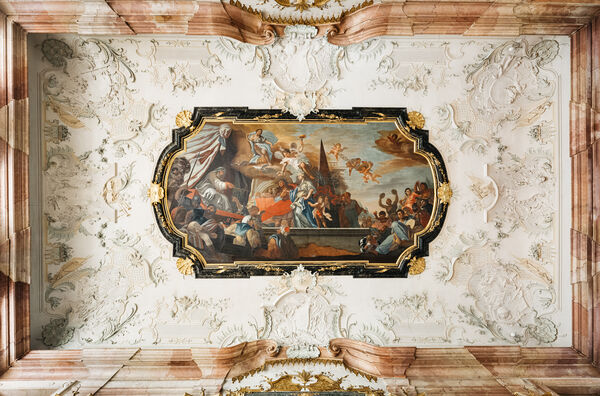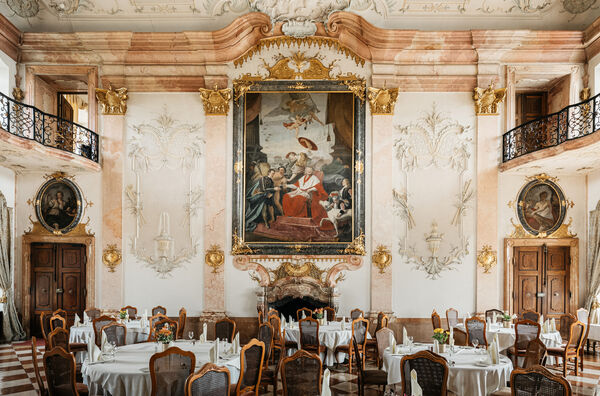
The Marble Hall:
The Marble Hall has remained unchanged since the 18th Century.
The Marble Hall hosted lavish balls, even in the time of Archbishop Firmian. Then as now, in the elegant room, it was the marble floor and wonderful stucco decor which gave the room its opulent splendor. The stucco ceilings, which were among the most beautiful of the time, were crafted by Johann Kleber. The stucco work resembles a sort of baroque cosmos. A closer inspection reveals a variety of interesting details and symbolic representation, for example:
- The four elements: water, air, earth and fire, left and right of each of the great paintings;
- The four (then-known) continents: Africa, Asia, Europe, and America, in the center of the ceiling borders;
- The four arts: astronomy, painting, architecture, and music, in the four corners of the ceiling
- The four stages of life: childhood, youth, maturity, and death, above the doors.

The ceiling painting came from the Salzburg artist Franz Anton Ebner and depicts the story of the “Marriage of Atalanta” from Greek mythology. The two large paintings at the sides are the creation of the Italian painter Andrea Rensi. The picture on the left depicts Prince-Archbishop Firmian (sitting in the red coat) as he hands his nephew Laktanz (in full armor) the deed of the palace. In the background, you can see Schloss Leopoldskron, which still had a red roof at the time (later removed by Laktanz to erect another floor for his self-portrait collection). The picture opposite shows Count Laktanz sitting with his wife Maximiliana von Lodron (1717 — 1793).

Salzburg Global Seminar:
In 1947, three American students by the names of Clemens Heller, Scott Elledge and Richard Campbell had the idea of organizing a seminar for both Americans and Europeans. Helene Thimig, Max Reinhardt’s widow, offered Schloss Leopoldskron as a place to hold the seminars. In the summer of the same year, more than 90 participants from the US and Europe met for a six-week-long dialogue in Schloss Leopoldskron- the start of Salzburg Global Seminar.
Salzburg Global Seminar now holds conferences on themes with global significance spanning five key areas: Peace & Justice, Education, Culture, Health, Finance & Governance.
Since the founding of Salzburg Global Seminar, more than 40,000 Fellows from across the world have visited the seminars. “Salzburg Global Seminar”, according to Max Reinhardt’s Son Gottfried, “combines the two worlds of Max Reinhardt: Europe and America. It cultivates the academic sector as Max Reinhardt had cultivated the cultural sector. Therefore, the Seminar would render homage to the spirit of the house.”
At the beginning of the 1950s, Salzburg Global Seminar was officially registered as a non-profit organization and rented the Schloss from Max Reinhardt’s Family. After the building was bought by Salzburg Global in 1959, there were renovations and reconstructions done to the Schloss.
75 Years in 12 Vignettes
With 75 years behind us and more than 40,000 Fellows in 170 countries, Salzburg Global obviously has many stories to tell. The following 12 vignettes have been selected not only for their ability to relate the history of the institution, but also to convey the unlikely symbiosis of a visionary enterprise, conceived at an American university that came to be situated in an eighteenth-century rococo palace in the heart of Europe with the goal of serving the global good.
